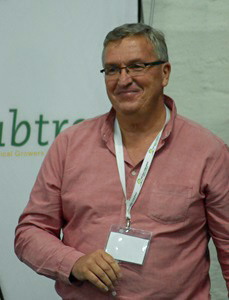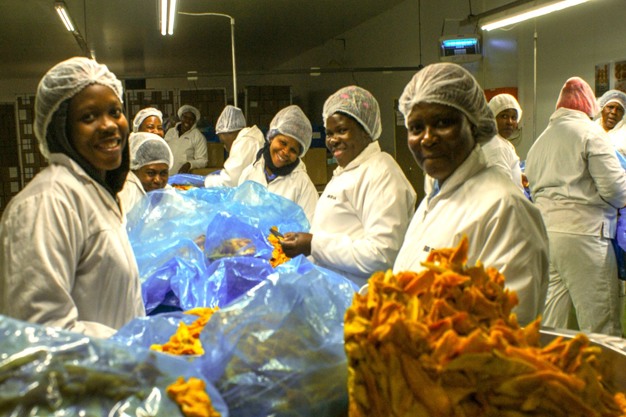 A year ago, Jaco Fivaz (right) from Mohlatsi Farm, a Hoedspruit mango farmer and former chair of the South African Mango Growers’ Association, realised their own mango drying facility was facing some export challenges. He spent months researching the global trade in dried mango and told the recent Subtrop symposium of what he considers European hypocrisy and unfair trade in Africa.
A year ago, Jaco Fivaz (right) from Mohlatsi Farm, a Hoedspruit mango farmer and former chair of the South African Mango Growers’ Association, realised their own mango drying facility was facing some export challenges. He spent months researching the global trade in dried mango and told the recent Subtrop symposium of what he considers European hypocrisy and unfair trade in Africa.
This year 220,000 tonnes of dried mango are expected out of the three million tonnes of all fruit dried worldwide.
At the same time, South African drying facilities have dwindled and some of them, they’ve told Jaco, were still unsure whether they’d be operational this year, while others had already indicated they would not be drying mangoes this year.
Over the past 20 years, between 10 and 20% of South African mangoes have gone to processing (luckily, Jaco pointed out, since fresh exports crashed in 2002/2003).
The leading suppliers of dried mango have changed a lot over last ten years: at the moment the European Union imports 7,000 tonnes of dried mango per year from Burkina Faso, South Africa and Ghana (in that order); 70% conventional dried mango, 25% organic dried mango and 5% sweetened.
The growth in dried mango imports from Europe is between 5 and 6%, with the biggest growth in France while Germany still imports the most (around 2,000 tonnes annually). Interest has risen in Spain and the Scandinavian countries. Only the United Kingdom’s demand for dried mango has stagnated.
“We are constantly told we’re too expensive.”Jaco noted that FOB prices for dried mango is 7 euros to 9 euros per kg delivered in Europe and sold at 20 euros to 30 euros per kilogram.
In South Africa it costs between R120 and R145 (7 euros) to produce one kilogram of dried mango.
The raw product making up a kilogram of dried mango costs R60 (almost 3 euros) while in Ghana, he said, it takes the equivalent of mangoes worth R3,60 (0.17 euro) to produce the same.
He set out that the labour component is approximately R28 (1.4 euro) in South Africa for that kilogram of dried mango. Ghanaian labour costs R7 (0.34 euro) to dry 1kg of mango.
“We are constantly told we’re too expensive. It is impossible for us to supply to Europe - they offer us below our production cost.”
Burkina Faso now produces 7,000 tonnes of dried mango (25% of European demand), Ghana 1,700 tonnes while South Africa dries 1,200 tonnes of mango every year.
Germany gets 70% of its dried mangoes from Burkina Faso, either for private label or from independent brands (as defines European trade), but there’s interest in product from Cambodia.
Mango drying in 12 African countries
Burkina Faso produced 700 tonnes of dried mango in 2014, in 2022 that figure had risen to 3,800 tonnes. Timini, with a South African partner, is potentially the biggest mango dryer in Burkina Faso with potential of 2,000 tonnes which, with the 1,000 annual tonnes from HPW, can between them supply half of Europe’s dried mango demand.
Jaco contacted industrial drying oven equipment suppliers to Africa and has extrapolated an additional capacity of over 300 tonnes of Burkinabe dried mango from planned new facilities.
“It’s not that difficult to dry mangoes. There’s been a lot of investment from Europe in setting up state-of-the art drying facilities in Mali, Burkina Faso, Sierra Leone, Gambia, Kenya, Mozambique, Zimbabwe, and I can carry on. The next one will probably be in Egypt.”
He lamented the role of South Africans in growing the “massive” competition that South Africa now faces.

Are SA factories witness to neocolonialism in dried fruit industry?
“Why was there suddenly an increase in interest in Africa from 2010? I don’t think it was just a business opportunity. In my personal opinion it resembles the concept of neocolonialism. Are Europeans involved in fair trade or barter trading? I had the audacity, according to a supermarket group in Europe, to say there’s nothing fair about paying a small-scale farmer R300 [14.6 euros]/tonne for fresh mangoes for drying and the people were earning only R39 [1.9 euro] a day, compared to the farmers in South Africa that they pay between R4,000 to R6,000 [293 euros] a tonne and our wage being above R200 [9.7 euros] a day. And they delisted Mohlatsi Dried Fruit.”
Given that the prices offered from Europe are below production cost, Jaco said, it is clear that mango drying should not play such a big role in the South African industry.
Moreover, he is sceptical about dried mango consumption among young people. The problem, however, is that a lot of growers planted mango cultivars just for drying.
The industry needs an export revival with new cultivars and new markets, as well as protection against mango imports.
The full presentation: ‘Can South African dried mangoes remain competitive?’
For more information:
Jaco Fivaz
Mohlatsi Farm
Email: mohlatsi@nix.co.za
